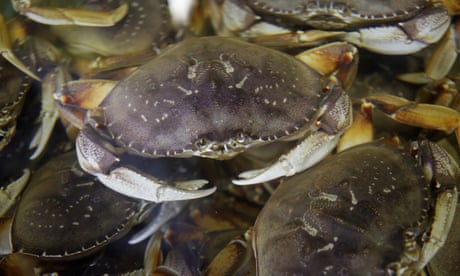Scientists want to use a chemical found in crab and lobster shells to make batteries more sustainable, according to research. “We think both biodegradability of material, or environmental impact, and the performance of the batteries are important for a product, which has the potential to be commercialised,” said Liangbing Hu , the director of the University of Maryland’s Center for Materials Innovation and lead author of the paper, published in the journal Matter . As the world transitions towards deploying green energy solutions and electric vehicles, the batteries being used for such technology also need to be eco-friendly.
But the chemicals used in conventional batteries such as lithium-ion can take hundreds or thousands of years to break down . These chemicals are also often corrosive and flammable. In some cases consumer-gadget batteries have caught fire on aircrafts , or caused fires in waste and recycling sites.
The researchers in Maryland have developed batteries that use a product derived from crustacean shells to store energy. Crustaceans such as crabs, shrimps and lobsters have exoskeletons made of cells that contain chitin , a kind of polysaccharide that makes their shells hard and resistant. This valuable material is abundant in nature and can also be found in fungi and insects , but is usually thrown away as food waste from restaurants and a byproduct of the food industry.
Scientists have long been researching its various applications – in biomedical engineering, for example, for wound dressing as well as anti-inflammatory treatments – and now, electrical engineering. Through chemical processing and adding acetic acid aqueous solution, chitin can ultimately be synthesised into a firm gel membrane and used as an electrolyte for a battery. An electrolyte is the liquid, paste, or gel inside a battery that helps ions – charged molecules – travel between one end and the other of a battery, allowing it to store energy.
By combining this chitosan electrolyte with zinc, a naturally occurring metal increasingly used to make batteries that are cheap and safe , Hu’s team was able to create a renewable battery. The battery is 99. 7% energy efficient even after 1,000 battery cycles, which is about 400 hours.
This means they can be quickly charged and discharged without significantly affecting their performance. “It is not an easy thing for batteries to operate at high current density. The displayed performance suggests the merit of chitosan-based material in this work,” said Hu.
The batteries are not flammable and the two-thirds of the battery made of chitosan can break down in soil thanks to microbial degradation in just five months, leaving behind recyclable zinc. Antonio J Fernández Romero, a professor of material sciences for energy production at the University of Cartagena in Spain, who was not involved in the study, said these were “outstanding properties”. He said: “The design of new batteries that are respectful of the environment, cheap and producing high discharge capacity, is one of the more important items that must be developed in the coming years.
” He added that biodegradability was key, and at this level the system seemed to work very well but it would have to be tested on a larger scale and under commercial use conditions. Sign up to Down to Earth Free weekly newsletter The planet’s most important stories. Get all the week’s environment news – the good, the bad and the essential Privacy Notice: Newsletters may contain info about charities, online ads, and content funded by outside parties.
For more information see our Privacy Policy . We use Google reCaptcha to protect our website and the Google Privacy Policy and Terms of Service apply. The design may pave the way for developing high-performance and sustainable batteries for green energy storage, according to Hu and the study authors.
“When you develop new materials for battery technologies there tends to be a significant gap between promising lab results and a demonstrable and scalable technology,” said Graham Newton, a professor of materials chemistry at the University of Nottingham, who was not involved in the study. He is an expert in sustainable batteries and researches how they can be improved. So far, according to Newton, the chitosan-zinc battery results are promising.
“There are some examples of batteries like this that have been commercialised and are being trialled as stationary energy storage systems,” said Newton. “There are still quite a few challenges to be met in the development of zinc ion batteries, but fundamental studies such as this are hugely important. ”.
From: theguardian
URL: https://www.theguardian.com/science/2022/sep/01/crab-lobster-shells-could-used-make-renewable-batteries



